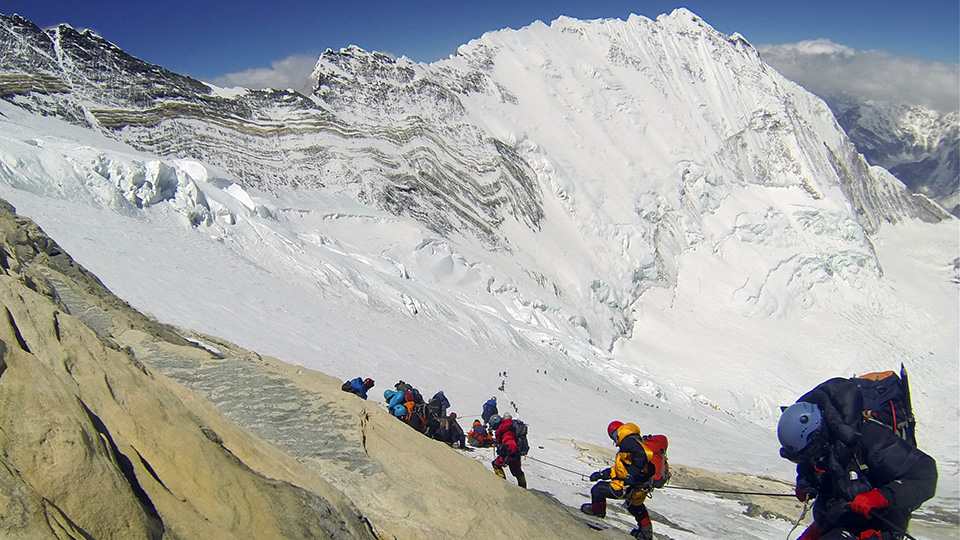
Extreme Exposure: Four climbers die in four days on Mount Everest
In this week's edition of Extreme Exposure—a weekly column featuring news and photography from the world of action and outdoor sports—Mt. Everest shows its teeth as four climbers perish and a big wave surfer nearly drowns in Fiji
Mt. Everest as Dangerous as Ever
Climbing the highest peak in the world is inherently dangerous. And this season had been relatively quiet in terms of tragedy on Mt. Everest. But that all changed this week as four deaths were reported in the region with another two climbers missing.
Eric Arnold, a 35-year-old Dutch climber, passed away in his sleep after summiting the mountain late last week, apparently suffering from altitude sickness. It had been his lifelong dream to summit the peak and he’d attempted it four times (he was denied a fifth time after suffering an injury at home). 34-year-old Australian Dr. Maria Strydom also succumbed to altitude sickness a day later—there are conflicting reports on whether or not Strydom reached the summit—but both climbers were with the outfitting company, Seven Summits Treks.
Their deaths came on the heels of 25-year-old Phurba Sherpa falling to his death while setting a fixed route near the summit. Then, 44-year-old Subush Paul died in base camp, also suffering from altitude sickness. Two members of his Indian team are also missing, marking a deadly four days on Everest. Some pundits are blaming the deaths on overcrowding on the world’s highest mountain. Altitude sickness is only cured by going to lower elevations and some believe these climbers weren’t able to get down fast enough because the route was clogged with climbers moving up and down the mountain.
• MORE EDGE: Marine is first combat amputee summits Everest
Aaron Gold Nearly Drowns in Fiji
Riding different kinds of mountains in Fiji, a massive swell hit the island chain over the weekend and big wave surfers flew to the region in droves. Cloudbreak, Fiji’s premiere wave, was enormous. Hawaiian Aaron Gold, who this year won the XXL Award for biggest paddle-in wave, fell on a gigantic set wave, took a two-wave hold down and was found floating face down by fellow surfers Uri Kurop and Mark Healey. According to reports, Kurop got Gold onto a jetski where he took him to a boat and Healey, one of the world’s best big wave surfers, performed CPR on him. A post on Gold’s Instagram account said that he was waiting clearance from doctors, who were checking for water in his lungs, before flying home. “Grateful to everyone involved in SAVING this man’s life and to GOD for allowing him to spend a little more time with us on earth,” read the post. Check out some of the clips from the massive session, here.
Mountain Bike Trails Sabotaged
In a weird story out of Colorado, the Denver Post reported last week that someone planted spikes in the new Little Scraggy Trail system in the Buffalo Creek area southeast of Gunnison. The spikes were literally embedded in the trail, mounted in custom-made bricks that were than buried in the trail with just the nail sticking up. Local riders Tim Fishback and Nick Kostecki discovered the boobie traps and reported them to the Forest Service, which is investigating the incident and hasn’t commented.
Nails embedded in a single-track trail are extremely dangerous traps as bikers carrying any amount of speed would be thrown out of control if they were to hit those spikes with any velocity. Luckily, the two cyclists were moving slow on the climb when they discovered the hidden nails.
This isn’t the first time traps have been discovered on trail systems—a trend often blamed on disgruntled hikers or nearby private land owners who don’t appreciate cyclists using trails. Spiked boards were found in the Prince Creek system near Carbondale, Colo. in 2014. A 64-year-old woman was convicted of booby-trapping trails in British Columbia after being caught on film while in 2013 an Oregon hiker was also convicted and in 2008, a man was arrested for digging pits and concealing them in Southern California. “It happens enough now that I would say there is a worrisome aspect, where people can see these as passive attacks on different user groups,” said International Mountain Biking Association spokesperson Mark Eller. “The factual way of looking at it is that this happens a few times a year now.”




